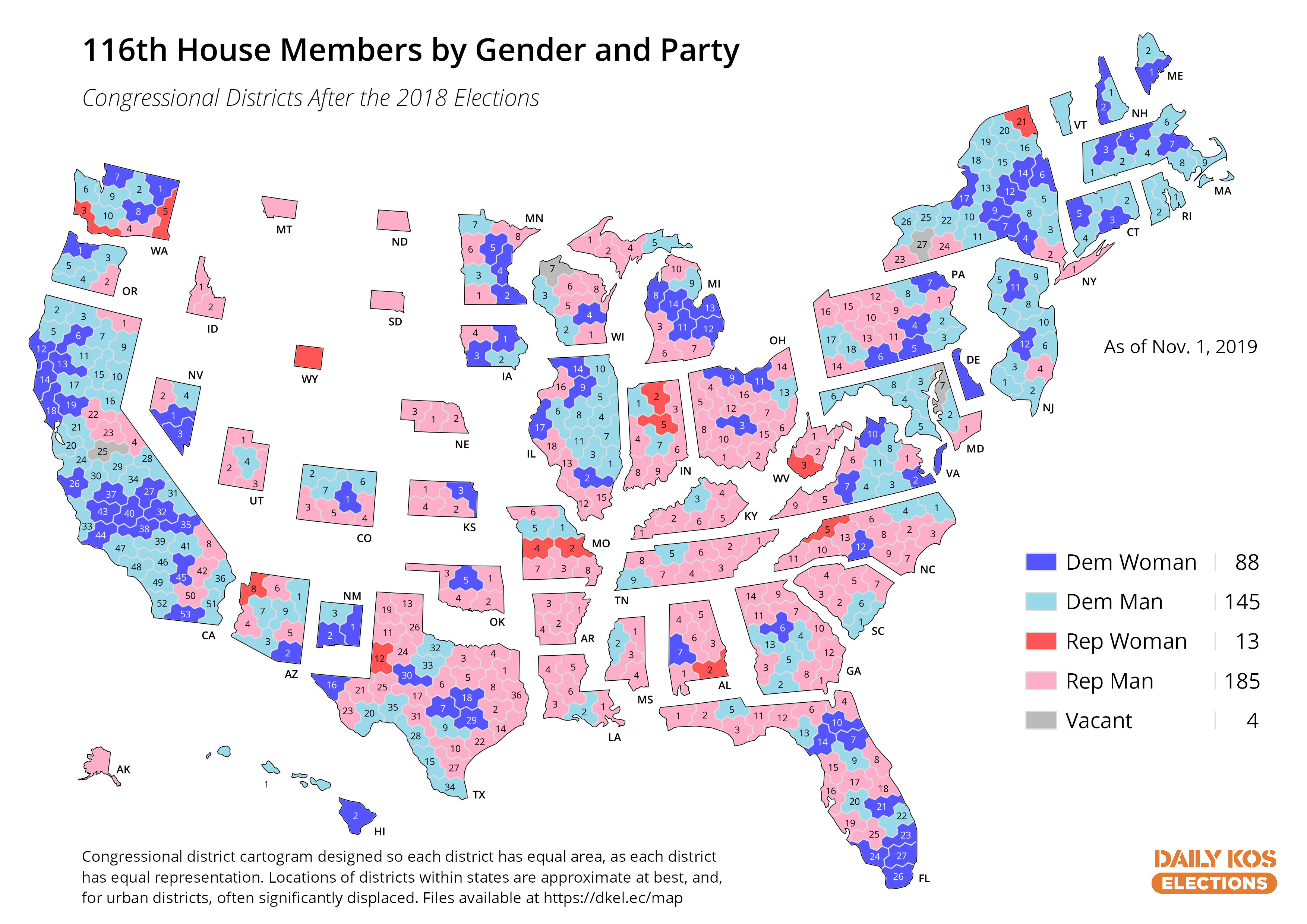This post has been updated to reflect the makeup of Congress as of Nov 1., 2019.
Following the conclusion of the 2018 congressional elections, Daily Kos Elections is pleased to unveil the most comprehensive guide you’ll find anywhere to the members of the new 116th Congress and their districts. This spreadsheet includes a wealth of demographic and electoral data on the members and the districts they represent, providing key insight on the makeup of Congress and statistics that play a critical role in understanding both the Senate and House. We've also visualized much of this data in maps and charts below.
The guide includes our own calculations of the 2008-2016 presidential elections by congressional district, the 2012-2018 House election results, and recent Senate elections by state. Additionally, it includes vital census demographic statistics, such as the racial breakdowns (including race by citizenship status) to provide the most accurate estimation of the eligible voter population. It also contains statistics about college educational attainment, median household income, and an estimate of the share of eligible voters who are white without a college degree, a demographic marker that has become highly salient in the Trump era.
For each voting member of the House and Senate, we also have stats on their gender, race or ethnicity, age, LGBTQ status, religious affiliation, and even a name-pronunciation guide. The 116th Congress will be both the most racially diverse and have the highest share of women on record. The chart below summarizes those stats by party for the House. (Note that we have assigned vacant seats to the party that last held them.)
Indeed, the new House will have more than 100 women for the first time in its history, though at 23% of the full chamber, women are still far from parity with men. As shown on the map below, 2018 marked a massive divergence by party when it comes to women representatives: A full 38% of House Democrats are women, but only 7% of House Republicans are. That’s a record high for Democrats and a historic low for Republicans.
 Click to enlarge
Click to enlarge
We have many more maps below.
The next map illustrates the members of the new House whose current tenure began following the Nov. 6, 2018 elections. Unsurprisingly, in light of their historic wave victory, there are twice as many newly elected Democrats as Republicans.
 Click to enlarge
Click to enlarge
Looking at those newly elected members by gender yields a stark contrast between the parties: Only one of the 30 new House Republicans is a woman, compared to 35 of the 62 new Democrats who are women—a majority of the Democrats’ incoming class.
 Click to enlarge
Click to enlarge
And as shown on map below, which breaks down membership by race and ethnicity, people of color also make up a record proportion of the House—one quarter. Again, there’s a sharp divide: Among Democrats, 42% of House members are people of color, but only 5% of House Republicans are.
 Click to enlarge
Click to enlarge
In total, heterosexual non-Hispanic white men still make up 60% of the House, but those numbers also diverge by party: They’re just 36% of House Democrats but an overwhelming 89% of House Republicans.
Turning to the Senate, the upper chamber is much less demographically representative of the nation as a whole than the House, as shown in the chart below.
Women make up 25% of the total (a similar proportion to the House): 36% of Democrats and 15% of Republicans. The Senate is significantly whiter than the House: Only 9% of senators are people of color, including just 13% of Democrats and 6% of Republicans. Heterosexual non-Hispanic white men comprise 70% of the Senate, but just like in the House, those numbers are significantly different by party: They make up 55% of Democratic senators and 79% of Republicans.
We’ll continue to analyze and visualize the demographics and geography of the new Congress members in an ongoing series of articles. You can also find our previous guide for the outgoing 115th Congress here.


